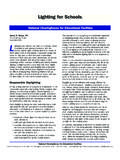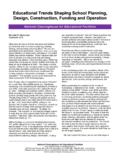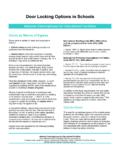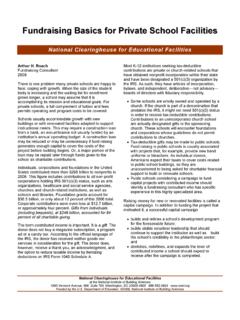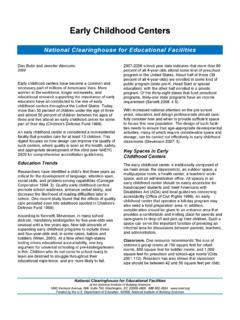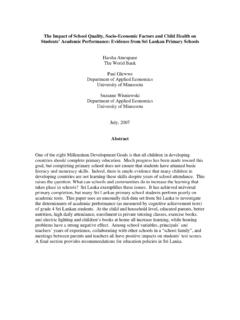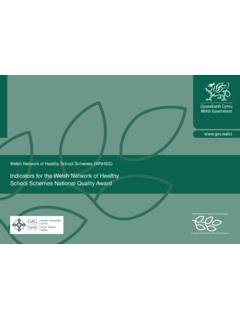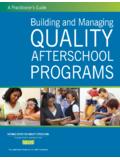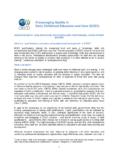Transcription of Do School Facilities Affect Academic Outcomes?
1 Mark SchneiderNovember 2002On any given School day, about twenty percent ofAmericans spend time in a School building. Theaverage age of our schools is close to fifty years,and studies by the General Accounting Office havedocumented widespread physical deficiencies in many ofthem. Faced with an aging building stock and growing,shifting student enrollments, states and communities areworking hard to build and modernize K 12 involved in School planning and design see this asan opportunity to enhance Academic outcomes by creat-ing better learning environments. Their logic is com-pelling how can we expect students to perform at highlevels in School buildings that are substandard?
2 We all know that clean, quiet, safe, comfortable, andhealthy environments are an important component ofsuccessful teaching and learning. But which facilityattributes Affect Academic outcomes the most and inwhat manner and degree?A growing body of research addresses these of it is good, some less so; much of it is inconclu-sive. The research is examined here in six categories:indoor air quality, ventilation, and thermal comfort; lighting; acoustics; building age and quality; School size;and class Air Quality, Ventilation,and Thermal Comfort There is a growing body of work linking educationalachievement and student performance to the quality ofair they breathe in schools.
3 Some of this research is justbeginning to make a cumulative mark, and some of theresearch, for example on thermal comfort, shows howmuch variation there is between individuals, makingguidance for School construction somewhat Air QualityPoor indoor air quality (IAQ) is widespread, and itseffects are too important to ignore. The GeneralAccounting Office has found that fifteen thousandschools suffer from poor IAQ, affecting more than eightmillion children or one in five children in America'sschools (General Accounting Office 1995). The IAQsymptoms identified irritated eyes, nose and throat,upper respiratory infections, nausea, dizziness,headaches and fatigue, or sleepiness have collectivelybeen referred to as sick building syndrome (EPA2000).
4 Ironically, the high incidence of symptoms stemmingfrom poor IAQ seems to have emerged as an unintendedconsequence of the electric power brownouts, oil embar-goes, and gas lines that characterized the 1970s energycrisis. In response to that national emergency, manybuildings, including schools, were fitted with air handlingsystems and controls that delivered less fresh air thannow is considered adequate. Most recommendationsfrom the Occupational Safety and Health Administration(OSHA) and the National Institute of Occupational Safetyand Health (NIOSH) now call for between fifteen andtwenty cubic feet of air per minute per person. Theseenhanced ventilation rates not only deliver more ade-quate supplies of fresh air but also help dilute or removecontaminants, especially chemical ( , formaldehyde,toluene, and styrene) and biological ( , mold and bac-teria) contaminants that have highly demonstrable negative health IAQ to Student PerformanceMost discussions linking IAQ to student performancedepend on a series of simple logical links: poor indoorair quality makes teachers and students sick and sickDo School Facilities Affect Academic Outcomes?
5 National Clearinghouse for Educational FacilitiesNational Clearinghouse for Educational Facilities1090 Vermont Avenue, , Suite 700, Washington, 20005 4905 888 552 0624 2002, National Institute of Building SciencesDo School Facilities Affect Academic Outcomes? 2 National Clearinghouse for Educational Facilities1090 Vermont Avenue, , Suite 700, Washington, 20005 4905 888 552 0624 2002, National Institute of Building Sciencesstudents and teachers can't perform as well as healthyones (EPA 2000, Kennedy 2001, Leach 1997). Thislogic seems unassailable, and researchers are develop-ing the scientific evidence to support notably, poor IAQ has been associated withincreased student absenteeism.
6 For example, Smedjeand Norback (1999) found a positive relationshipbetween airborne bacteria and mold and asthma in children, which in turn increased absentee rates (alsoRosen and Richardson 1999, EPA 2000). Further, theAmerican Lung Association (ALA) found that Americanchildren miss more than ten million School days eachyear because of asthma exacerbated by poor IAQ (ALA2002, EPA 2000). Rosen and Richardson (1999) found that improving airquality through electrostatic air cleaning technologyreduces absenteeism. Their experiment, conducted intwo Swedish day-care centers, one old and the othermodern, collected data on absenteeism and air qualityover three years. The air cleaning technology was operational during only the second of the three testyears, and absenteeism fell during that period in bothschools.
7 But only in the older School did the changereach statistical significance (absenteeism dropped percent in year one to percent in year two,but upon removing the air cleaners, the rate increasedto percent in year three).Temperature and HumidityTemperature and humidity Affect IAQ in many ways, perhaps most significantly because their levels can promote or inhibit the presence of bacteria and example, a study of Florida classrooms with relativehumidity levels greater than seventy-two percent foundvisible mold growth on the ceilings and complaints ofallergy symptoms associated with sick building syndrome(Bates 1996). At the other end of the humidity scale,Leach (1997) reported findings of a 1970 study done inSaskatoon, Saskatchewan, Canada, which found absen-teeism was reduced in schools by twenty percent as relative humidity in the Facilities was increased fromtwenty-two to thirty-five percent.
8 Wyon (1991) showedthat student performance at mental tasks is affected bychanges in temperature, and Fang et al. (1998) foundthat office workers are most comfortable in the low endof temperature and humidity comfort zones. These findings support the idea that students will perform mental tasks best in rooms kept at moderate humiditylevels (forty to seventy percent) and moderate tempera-tures in the range of sixty-eight to seventy-four degreesFahrenheit (Harner 1974, Wyon, Andersen, andLundqvist 1979).Ventilation Effects on PerformanceIt seems obvious that in a sealed space, without theavailability of fresh air from outside, the occupants ofthat space will die from asphyxiation.
9 Yet despite thisknowledge, deaths of workers in confined spaces consti-tute a recurring occupational tragedy (NIOSH 1986).While we certainly seek to avoid such extreme conditionsin schools, a surprising number of classrooms lack adequate ventilation, and evidence is accumulating tosupport the common-sense notion that occupants of aclassroom without good ventilation can't function normally and can't learn at their full purpose of ventilating classrooms and School build-ings, at minimum, is to remove or otherwise dilute contaminants that can build up inside. Such contami-nants come from people breathing, from their skin,clothes, perfumes, shampoos, deodorants, from buildingmaterials and cleaning agents, pathogens, and from ahost of other agents that, in sufficient concentrations,are need especially good ventilation because children breathe a greater volume of air in proportion totheir body weight than adults do (Kennedy 2001,McGovern 1998, Moore 1998) and because schoolshave much less floor space per person than found inmost office buildings (Crawford 1998).
10 But because ofthe high costs of conditioning the ventilation air inschools to comfortable temperatures before it is circulated, the designers and operators of School build-ings can be the unwitting architects of learning spacesthat impair learning and health by offering inadequateventilation whether this results from economic meas-ures, ignorance, neglect, poor maintenance, or some combination of these of the first symptoms of poor ventilation in a build-ing is a buildup of carbon dioxide caused by human Do School Facilities Affect Academic Outcomes? 3 National Clearinghouse for Educational Facilities1090 Vermont Avenue, , Suite 700, Washington, 20005 4905 888 552 0624 2002, National Institute of Building Sciencesrespiration.
